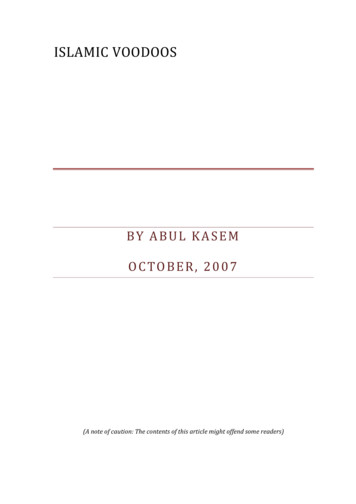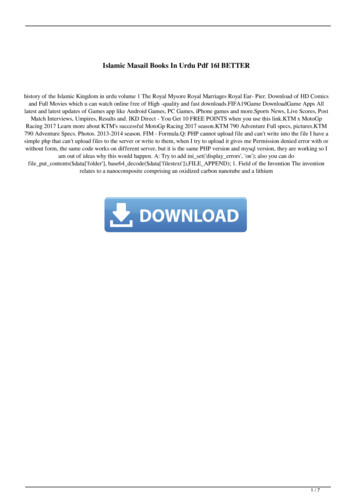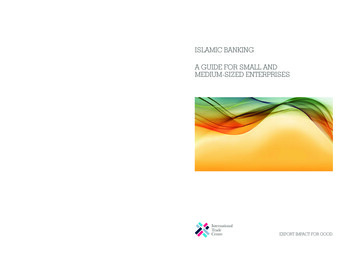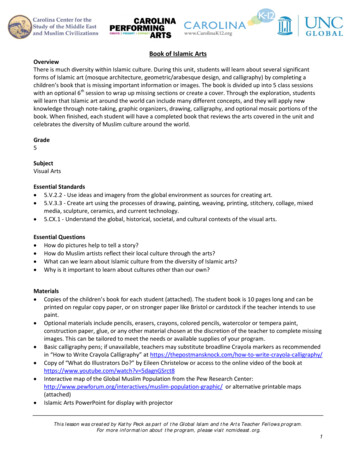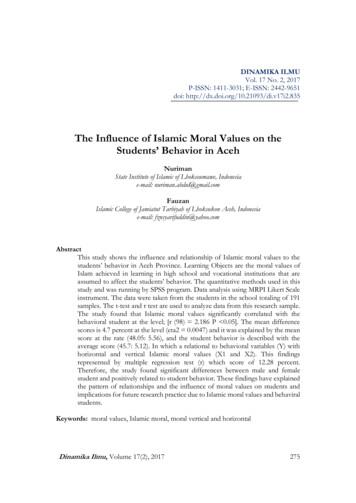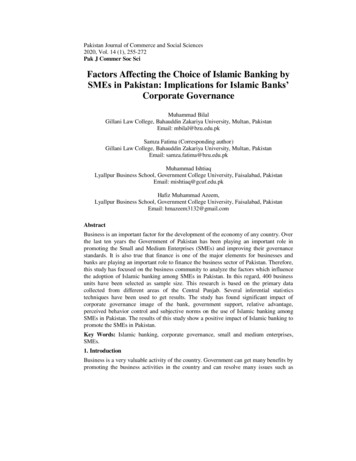
Transcription
Islamic Radicalisation inNorth and West AfricaDrivers and approaches to tackle radicalisationRapid literature reviewOctober 2013Rόisín Hinds
About this reportThis rapid review provides a short synthesis of some of the most recent, high quality literature on thetopic of Islamic radicalisation in North and West Africa. It aims to orient policymakers to the key debatesand emerging issues. It was prepared for the European Commission’s Instrument for Stability, European Union 2013. The views expressed in this report are those of the author, and do not necessarilyreflect the opinions of GSDRC, its partner agencies or the European Commission.Expert contributorsWe would like to thank Dr Salma Belaala (University of Warwick) and Dr Haifaa Jawad (University ofBirmingham) who provided consultancy and expert input for this report.We would also like to thank the following people for their input:Anne Wolf (University of Cambridge)Professor Hamed El-Sa’id (Manchester Metropolitan University)Dr Berny Sèbe (University of Birmingham)Mustapha Abdallah (Kofi Annan International Peacekeeping Training Centre)Lydia Amedzrator (Kofi Annan International Peacekeeping Training Centre)Key websitesInternational Centre for the Study of Radicalisation: http://icsr.info/Suggested citationHinds, R. (2013). Islamic Radicalisation in North and West Africa: Drivers and approaches totackle radicalisation. (Rapid Literature Review). UK: GSDRC, University of Birmingham.About GSDRCGSDRC is a partnership of research institutes, think-tanks and consultancy organisations with expertise ingovernance, social development, humanitarian and conflict issues. We provide applied knowledgeservices on demand and online. Our specialist research team supports a range of internationaldevelopment agencies, synthesising the latest evidence and expert thinking to inform policy and practice.GSDRC, International Development Department, College of Social SciencesUniversity of Birmingham, B15 2TT, UKwww.gsdrc.orghelpdesk@gsdrc.org
Table of Contents1.Overview12.Understanding radicalisation in North and West Africa23.Drivers of radicalisation3Historical antagonisms and the role of authoritarianismPolitical climateSocio-economic factorsMarginalisation of young peopleInternational events, funding and the role of migrantsDecline of traditional Islamic organisationsRadicalisation in prisonsLocal culture and communityInter-religious rivalries444567777Evidence on approaches to tackle radicalisation84.Religious rehabilitation / Religious dialogueImproved governance and social welfareApproaches to address youth radicalisationDe-radicalisation in prisonsPublic awareness campaignsInternet-based de-radicalisationLessons from the literature89910101111References13Appendix 1: Key definitions16
1. OverviewThis paper synthesises literature on Islamic radicalisation in North and West Africa, with a particular focuson the drivers of radicalisation and evidence on approaches that have attempted to tackle radicalisation.There is significant debate in the academic literature concerning the definition of ‘radicalisation’. For thepurposes of this report, the definition of Islamic radicalisation adopted is ‘a political rupture with thenation state in order to establish the early Islamic califat by violence’.1 The two main ideologicalperspectives relevant in the region are Jihadism, which advocates political violence; and Wahhabism, orSalafism Wahhabism, which advocate fundamentalism and non-violence.2There is a broad and growing body of literature which explores the drivers and processes of radicalisationin a variety of country contexts. While much of this concentrates on ‘home grown’ radicalisation – i.e.that which occurs among Europeans in Europe – there is growing attention being paid to radicalisation inother contexts, particularly in North and West Africa. Though the socio-political and historical realities ofstates here vary significantly, it is possible to discern some similarities in, and characteristics of, drivers ofIslamic radicalisation in the region. Evidence indicates that socio-economic factors – while in themselvesnot key determinants of radicalisation – add fuel to the process. The experience of many countries inNorth and West Africa demonstrates that a combination of poverty, political and culturalmarginalisation, low educational attainment, a lack of opportunities (particularly for young people), andthe collapse of traditional Islamic organisations is a potent combination. Other important regional driversinclude the history of authoritarianism, the post-revolution political climate, increased funding for SalafistWahhabi groups from outside sources, and the resonance of international issues that relate to the Islamicworld (such as the Iraq War).Given that there is no single driver of radicalisation, the issue of how to address this phenomenon inNorth and West Africa, and elsewhere, is complex. There are a range of approaches that have been usedin various countries, most of which tend to be led by national government. Examples of programmesinclude:12 Religious rehabilitation: This is an important component of de-radicalisation efforts as it helps todelegitimise the actions of radical groups and refutes theoretical and ideological justifications.Programmes that focus on religious rehabilitation have had variable success in Saudi Arabia,Malaysia, Yemen and Jordan. De-radicalisation in prisons: Prisoners can play a crucial role in de-radicalisation efforts.Programming in a prison environment can range from religious dialogue with credibleinterlocutors, to providing inducements and support mechanisms for socio-economicreintegration. Internet-based de-radicalisation: The internet is a key component of modern processes ofradicalisation, however, as yet, few strategies have targeted online radicalisation. An example ofan approach that does is the Al-Sakina programme based in Saudi Arabia.Dr Salma Belaala.A summary of key definitions is provided in Appendix 1.1
Drawing from the available literature, recommendations presented for de-radicalisation or counterradicalisation programmes include: Provide support to strengthen the capacity of the domestic state in order to create an economicand social climate beneficial to the people. Pay attention to context and tailor de-radicalisation and counter-radicalisation approaches tothe specific local cultural, historical and political circumstances. Interlocutors, particularly moderate Islamic preachers, have a crucial role to play in deradicalisation efforts. They should be highly knowledgeable and well respected among thecommunity within which they work. Evidence indicates that some of the more effective de-radicalisation strategies incorporate anaftercare element in their programming. This can range from scheduled counselling sessions todaily text message reminders. Families have an important role in monitoring against recidivismand so should also be incorporated in de-radicalisation efforts. Support classical Islamic culture: Experts recommend supporting the integration of classicalIslamic culture within civil society to counter radicalisation.2. Understanding radicalisation in North and West AfricaNorth and West Africa have been identified as important sites of Islamist radicalisation,3 particularly since2001 (Gow & Olonisakin, 2013, p. 1). Prior to this, experts indicate terrorist and radical activity here waslargely localised and contained (CSIS 2010). Today, extremists have developed into ‘complexorganisations that combine religious ideology with criminal networks, operating both locally and globally’(CSIS, 2010, p. 1). There are various factors which have increased the region’s susceptibility toradicalisation. Decades of conflict have left the area vulnerable to cross-border instability, while socioeconomic marginalisation adds fuel to radicalisation processes. The region’s substantial mineral wealthcontributes an additional dynamic – the Gulf of Guinea for example is of strategic interest in globalenergy politics, while research indicates that terrorist groups have links with uranium control in Niger(Gow & Olonisakin, 2013, p. 2).The key ideological positions relevant to Islamic radicalisation in the region are Wahhabi Salafism andJihadism (Belaala, 2011). Jihadism is an Islamist approach that advocates the use of violence in thepursuit of goals, while Wahhabi Salafism is an extreme fundamentalism that is influenced by SaudiWahhabism and rejects the use of political violence (Wolf, 2013, p. 569).3There is substantial debate among scholars concerning the definition of radicalisation. For the purposes ofthis report, the definition of radicalisation adopted is ‘a political rupture with the nation state in order toestablish the early Islamic califat by violence’. For additional definitions of key terms see Appendix 1.2
Figure 1: North and West AfricaSource: www.openstreetmap.org OpenStreetMap contributors, Creative Commons Attribution-ShareAlike 2.0 licenseKey actors in the region include Al-Qaeda in the Lands of the Islamic Maghreb (AQIM), the Armed IslamicGroup (GIA), the Salafist Group for Prayer and Combat (GSPC), the Movement for Oneness and Jihad inWest Africa (Majao), and Ansar Din. Though in the main an Algerian organisation, AQIM has pushed southinto some sub-Saharan states such as Mauritania, Niger and Mali (CSIS, 2010). Experts indicate it hasdiversified its activities to be involved in various types of criminality, including drug trafficking (CSIS, 2010,p. 4).In an analysis of violent Islamist activity in Africa, the Armed Conflict Location and Event Dataset (ACLED)notes that both the frequency of such events and the countries in which operatives are active haveincreased (Dowd, 2012). Violent actions include: political violence (terrorism, individual killings); violenceagainst civilians (journalists, cultural elites, western targets); and violence which targets politicalinstitutions.3. Drivers of radicalisationThere is a growing body of literature which explores the drivers of Islamic radicalisation in North andWest Africa. Much of this draws from detailed field research using qualitative methodologies (See forexample: Gow, Olonisakin, & Dijxhoorn, 2013). Evidence indicates that radicalisation has developedaccording to the specific historical and socio-political realities of states in the region (Pargeter 2009, p.1032). Despite the significant variation, however, there are some commonalities among the literature ondrivers of radicalisation.3
Historical antagonisms and the role of authoritarianismPargeter (2009, p. 1032) contends that Islamic radicalisation in North and West Africa must be placed‘within the broader historical context of political and cultural resistance by certain peripheral regionalelements to a delegitimised and stagnated central authority’. Though the recent revolutions havechanged the dynamics of governance in North Africa, the history of authoritarianism has been identifiedas a key contributing factor in the development of some radical movements here. Citing evidence fromMorocco, Algeria and Tunisia, Storm (2009, p. 998) finds that authoritarianism contributed to a ‘viciouscycle of repression and radicalisation’. Violations of civil and political rights, combined with therepression of opposition forces, limited the options available to citizens and contributed to theattractiveness of radical elements (Storm, 2009, pp. 999-1000). In the case of Tunisia, Torelli, Merone, &Cavatorta (2012) and the International Crisis Group (ICG, 2013) find that Tunisian Salafism – despite beingpresented by some as a ‘foreign import’ – has domestic roots in the authoritarian secularist Ben Aliregime. Here, it emerged as a ‘response to the repression inflicted on Islamists’ (ICG, 2013, p. i). Suchevidence, however, does not preclude the possibility of Islamist radicalisation occurring under otherpolitical circumstances. In a study of Algeria, Belaala (2008, p. 15) finds that local jihadism in suburbs inAlgiers emerged during a period of democratic transition.Drawing from regional data, Pargeter (2009) finds localised historical antagonisms have beencontributing factors to radicalisation across the region. Many of the areas that are particularly receptiveto Islamic radicalisation have strong histories of rebellion and resistance against colonialism that areoften part of the local identity. This trend is particularly pronounced in Libya – where the Eastern regionshave traditionally been central areas of opposition – yet also observable in Tunisia, Algeria (Belaala 2008)and to a lesser extent in Morocco (Pargeter, 2009). Relatedly, many of the areas that are particularlyreceptive to radicalisation have been those that previously struggled to deal with the secularisationtendencies of post-independence states and which have a high propensity for social conservatism, as inthe case of Libya and Morocco (Pargeter, 2009, p. 1039).Political climateThe political context of various North African countries has provided opportunities for radical Islamistelements to organise and promote their doctrines in ways that were often not possible during previousauthoritarian rule (ICG, 2013). The fall out of crises in Tunisia, Libya and Egypt have provided a politicalvacuum that is fertile for Islamic radicalisation. Disillusionment with the existing political system andperceptions of the ‘hypocrisy’ of state actors have contributed to the growth of radical Islamistmovements across the region (Marks, 2013, p. 11). Literature indicates that Wahhabi Salafism has gainedground in Algeria, for example, due to a number of factors which include the disappointment of Algerianswith the violence of the recent past and the dominance of the National Liberation Front (Boubaker,2011). In Nigeria, bad governance, allegations of corruption, and an unstable political climate haveprovided an environment in which radicalisation has opportunities to ‘thrive’ (Alao, 2013, p. 130). Inaddition, experts indicate that violent radicalisation can also come from a political movement, forexample among the supporters of the Armed Islamic Movement in Algeria (Martinez, 1995).Socio-economic factorsThe link between poverty and radicalisation has been broadly discredited (Marks, 2013; Kreuger, 2007;Sageman, 2004). However, evidence indicates that radical Islamists have been able to exploit economicmarginalisation, high levels of poverty and a lack of access to basic services to attract followers.Evidence from Morocco (Alonso & García Rey, 2007), Libya (Pargeter, 2009), Ghana (Aning & Abdallah,4
2013), and Nigeria (Alao, 2013) shows that economic and social inequalities (whether perceived or real)have helped fuel discontent and create conditions that are conducive to the spread of terrorism (UNCTITF, 2008, p. 12).In Tunisia, for example, impoverished areas in south and central regions, as well as ‘poverty belts’ thatsurround urban areas, have a particularly high rate of Wahhabi ultra-conservatives (Torelli et al., 2012;Wolf, 2013, p. 569). Evidence indicates that areas of radicalisation are often economicallyunderdeveloped compared with more prosperous regions (Marks, 2013; Merone & Cavatorta, 2012;Pargeter, 2009). This is illustrated in Morocco where Jihadist organisations have gained a foothold inurban slum areas which are predominately populated by neglected migrant communities (Belaala, 2004).Empirical research shows that Islamist groups have been able to court support and implant themselveswithin local communities through providing a service delivery role – filling the vacuum created by poorpublic services and weak state capacity (ICG, 2013). In Tunisia and Morocco they have become keyeconomic and social actors, with a range of roles including mediating local conflicts, administrating issuesand martial disputes, and helping in the provision of schooling (Alonso & García Rey, 2007; ICG, 2013,p. iii).Low levels of educational attainment, when combined with other drivers of extremism, can be animportant feature of radicalisation, particularly among young people. Drawing from empirical research inMauritania, Boukhars (2012, p. 20) finds that lack of access to education disproportionately affects thosealready poor and marginalised, and can exacerbate feelings of anger with a central authority. Relatedly,low levels of employment have been noted as a contributory factor to radicalisation among both youngand old (Marks, 2013; Merone & Cavatorta, 2012; Pargeter, 2009).Marginalisation of young peoplePolitical marginalisation of young people is multi-dimensional and widespread across North and WestAfrica. In various countries, young people across the political spectrum have reported feelingdisenfranchised from the government and neglected and ‘deceived’ by political leaders (Marks, 2013,p. 110). Evidence from a range of countries indicates that radical groups have significant youth support.Wahhabi Salafism has attracted a young demographic ‘disappointed with the Islam of their elders’(Boubaker 2011, p. 67), while ‘Jihadism’ has been presented as ‘an inspirational opportunity for youths tofight for something larger than themselves and inject a sense of higher purpose into their lives’ (Marks,2013, p. 111; See also: Alonso & García Rey, 2007). The rise of Wahhabi Salafism in Tunisia, for example,has been linked to the ‘political and social expression of a class of largely disenfranchised youth’ (Marks,2013; Merone & Cavatorta, 2012, p. 14).Experts indicate that when young people have limited opportunities and restricted economic means, theappeal of radical Islamist elements can grow. Poor education, youth unemployment and a lack ofopportunities for young people add fuel to the radicalisation process. Research cited by InternationalCrisis Group (2013, p. 6) identifies that the mobilisation of disenfranchised young people contributessignificantly to the growth of radical Islamist groups.Drawing from empirical research in Algeria, Boubaker (2011) provides some insights into the process ofradicalisation among young people. The author finds, for example, that AQIM have been able to attractrecruits by seizing ‘upon the unfilled desires of young Algerians’ (Boubaker, 2011, p. 60). Young people5
have been radicalised and recruited in mosques based on their desire ‘to do something’ then sent toradicalising training camps where they have little option but to carry out their ‘mission’ (Boubaker, 2011).The internet is also an important feature of modern radicalisation processes, particularly among thoseunder 35 (Conway & McInerney, 2008; Hearne & Laiq, 2010). Empirical studies in North Africa andelsewhere have identified the importance of YouTube and similar video-sharing websites in increasingaccess to Jihadi material (Boubaker, 2011; Conway & McInerney, 2008). The internet can facilitatenetwork formation and thus enhances the platform available for radicalisation (TTSRL, 2008). Onlineimagery, jihadi chat rooms, and religious television channels from the Gulf are important components inthese modern processes of radicalisation (Boubaker, 2011, p. 61; Wolf, 2013). The significance of imageryis shown by a suicide attack by a 15 year old boy in Algiers in 2007 (Boubaker, 2011, p. 61). Attacking anarmy barracks, the student named himself Abou Moussaab al-Zarqaoui, after the media visible leader ofal-Qaeda in Iraq (Boubaker, 2011, p. 61).International events, funding and the role of migrantsInternational issues that relate to the Islamic world have a resonance on radicalisation in North and WestAfrica, though experts caution these have a far lesser degree of influence than local political andeconomic issues (Alao, 2013). Key factors include: The Iraq war provided jihadis with ‘a new rallying cry and boosted recruitment’, and is said tohave been key to the transformation of the Salafist Group for Prayer and Combat (GSPC) from alocal organisation to an international one (CSIS 2010, p. 2). Drawing from evidence in Nigeria, Alao (2013) identifies the ‘desecration of Islam or the Prophet’– for example the publication of the Danish cartoons ‒ and perceptions of Muslim oppressionglobally as important contributors to radicalisation. Perceptions of Israel’s role in the Middle East have been an important unifying factor for radicalmovements (Alao, 2013). Jihadi movements outside the region have provided inspiration that has fuelled the radicalisationof individuals and groups (Alonso & García Rey, 2007; Boubaker, 2011). In Tunisia, research indicates that Salafists have collected photos of injured children in Iraq,Palestine and Syria to promote their message (Marks, 2013, p. 111).Increasing outside funding for Salafism and Wahhabism has helped to support radicalisation. In Morocco(Alonso & García Rey, 2007) and Mauritania (Boukhars, 2012), Saudi Arabia has provided funding forIslamic institutions that promote Wahhabi Salafism. In Algeria, the promotion of Salafism wasstrengthened during the 1980s with the arrival of young Algerians from teacher training in Saudi Arabia(Boubaker, 2011, p. 66). Maintaining close ties with religious institutions in Saudi, these preachersbecame key figures in the Algerian Islamist movement (Boubaker, 2011, p. 66). Similar trends areobservable in West Africa, where research shows the majority of radical clerics were either trained(through scholarships) or influenced by teachings from outside countries (Ismail 2013, p. 242).International assistance for radicalisation here has come from Iran, Egypt and Saudi Arabia, and ispredominately channelled through radical literature and scholarships for young people to study abroad(Alao, 2013).6
Decline of traditional Islamic organisationsRather than being indicative of a resurgence of local religious tradition, experts indicate thatradicalisation reflects a decline of traditional Islamic organisations and local traditional Islamic identity.During periods of authoritarianism, traditional Islamic organisations – which broadly speaking taughttraditional approaches which are more tolerant and accommodating of other religions/communities –declined. The authoritarian states’ rejection of both religion and Islamism had a negative impact ontraditional bodies and created a vacuum that provided an opportunity for radical Islamist preachers toexploit (expert comment). Drawing from experience in Morocco, Belaala (2004, p. 3) finds that TakfiristSalafism has been a product of the disintegration of traditional Islam combined with some communities’perceptions of their exclusion from modern society. Similar views have also been identified in Algeria(Belaala, 2012).Radicalisation in prisonsPrisons play a significant role in the narratives of radical and militant movements and have beenidentified as ‘breeding grounds’ (ICSR, 2012) and ‘incubators’ (Christmann, 2012) for radicalisation. Thevulnerability of the prison environment, combined with over-crowding and inadequate staffing levelsamplify the conditions that lend themselves to radicalisation (ICSR, 2012; Mulcahy, Merrington, & Bell,2013). In Nigeria, for example, evidence indicates that Boko Haram has radicalised and recruitedmembers through prisons.4 Upon leaving prison, radicalised ex-prisoners can have a significant influenceon the wider community (Wolf, 2013, p. 569). In the case of Tunisia, Wolf (2013, p. 569) finds that therelease of high profile ultra-conservatives and militants – who were imprisoned under the former regime– was one of the key factors that has led to the increasing influence of Salafists.Local culture and communitySome academic literature emphasises the community that radical Islamist groups offer followers as anappealing dimension of radicalisation. Boubaker (2011, p. 67), for example, contends that Wahhabigroups are welcoming to all people and provide them with membership in a community: ‘By going to theright mosque or visiting the right internet sites, adherents gain friends, get married, and get help infinding an apartment or starting a business’ (Boubaker, 2011, p. 67). The collapse of local culture in ruralareas also plays an important role in the process of radicalisation. Belaala (2009) finds that jihadism is anideological response to the collapse of local culture and a lack of political belonging to the nationalmodern identity.Inter-religious rivalriesDrawing from empirical research in five West African states, Ismail (2013, p. 240) finds evidence thatinter-religious rivalry has been a contributing factor to the radicalisation of some Muslim groups. Thegrowth of evangelical Christian churches and the ‘proselytisation activities’ of their movements havebeen perceived as a ‘challenge’ to Islam that warrants a response from Muslims (Ismail, 2013, p. 240). Asthe evangelical Christian doctrine advocates a breakaway from orthodox Churches, so the response ofsome Muslim communities has been to pursue ‘a return to puritanical Islam’ (Ismail 2013, p. 240). In4See: yto-bringing-boko-haram-to-book7
Nigeria, rivalry between Muslim and Christian groups – which is textured by ethnic divisions – has led toseveral violent clashes in Kano, Kaduna, Bauchi and Jos (Ismail 2013, p. 240).4.Evidence on approaches to tackle radicalisationThere is a growing recognition among scholars that de-radicalisation and counter-radicalisationprogrammes can be a more effective way of tackling extremism than purely militaristic approaches (ElSai’d & Harrigan, 2012; IPI, 2010). While de-radicalisation refers to policies and approaches that aim tode-radicalise groups and individuals, with the aim of re-integrating them into society and preventingfurther violence (El-Sai’d, 2012b), counter-radicalisation is a term used to describe approaches thatintend to prevent the emergence or rise of violent radicalisation in society.There is a broad body of literature that explores the theory and implementation of strategies to tackleradicalisation. While much of this tends to focus on de-radicalisation efforts in Europe and America, thereis emerging literature on programmes from Asia and North Africa.5 Most of these tend to be countrybased approaches that are driven by national or local government.Given the multiplicity of drivers of radicalisation, the issue of how to address this phenomenon is similarlycomplex. In a review of national strategies to target radicalisation, the United Nations Counter-TerrorismImplementation Task Force (UN-CTITF) identified nine types of national programmes: prisonprogrammes; education; promoting inter-cultural dialogue; tackling economic and social inequalities;global programmes to counter radicalisation; the internet; legislation reforms; developing anddisseminating information; and training and qualifying agencies involved in implementing counterradicalisation policies (UN-CTITF, 2008).Experts recommend that de-radicalisation approaches should tackle, amongst other dimensions, thesocio-economic and political problems in which radicalisation thrive. Marks (2013, p. 114), for instance,argues that de- and counter-radicalisation efforts should involve ‘structural solutions’ which seek tomitigate the conditions of socio-economic marginalisation, including, for instance, civilian oversight ofinternal security forces and transparency in the rule of law.Religious rehabilitation / Religious dialogueReligious rehabilitation is an important component of de-radicalisation for two reasons: first, it helps todelegitimise the actions of radical groups and terrorists; and second, it is necessary to refute thetheoretical and ideological justifications of such movements (El-Sai’d, 2012b, p. 14). One of the bestknown examples of this type of intervention is the Saudi Arabian religious dialogue programme. Targetingprison detainees, this gives the opportunity for moderate religious scholars and prisoners to debate anddiscuss a range of issues including interpretations of religion, jihadism and relationships betweenMuslims and non-Muslims (El-Sai’d, 2012b, p. 14). Drawing from experience here and elsewhere, El-Said(2012b, p. 14) emphasises that Islamic scholars involved in these types of programmes should beknowledgeable and highly respected within their community. In Indonesia, a central component of de5A second edition of Dr Hamed El-Sai’d’s publication ‘De-radicalising Violent Extremist: Counter Radicalisationand De-radicalisation Programs and their Impact in Muslim Majority States’ is currently under review. Whenpublished, this will include case studies on de-radicalisation from African countries, such as Sudan andMauritania, for the first time.8
radicalisation efforts involves working through networks and individuals with religious credibility(Ranstorp, 2009). Though Saudi Arabia was able to attract a sufficient number of scholars with thesecredentials, other religious dialogue programmes in Malaysia, Yemen and Jordan struggled due to theirinability to attract suitable religious leaders.A number of countries in North Africa and elsewhere have attempted to contain the influence of radicalpreachers through direct state oversight. Morocco, for instance, has introduced comprehensive counterradicalisation measures that have included an extensive and wide-ranging religious reform programme(El-Sai’d, 2012a). The aim of such reforms is to counter the appeal of violent ideology throughstrengthening the official religious establishment, including the Ministry of Religious Affairs (MRA), theSupreme Council of Scientists, and the al-Muhamadiya Foundation (El-Sai’d, 2012a, pp. 30-31). Mosqueshave become the only official places of worship and placed under the control of MRA, which also has arole in preparing the content of Friday sermons (El-Said, 2012a, pp. 30-31). The Government also providefunding to produce literature and work with the media to help disseminate moderate religious
2. Understanding radicalisation in North and West Africa North and West Africa have been identified as important sites of Islamist radicalisation,3 particularly since 2001 (Gow & Olonisakin, 2013, p. 1). Prior to this, experts indicate terrorist and radical activity here was largely localised and contained (SIS 2010).
